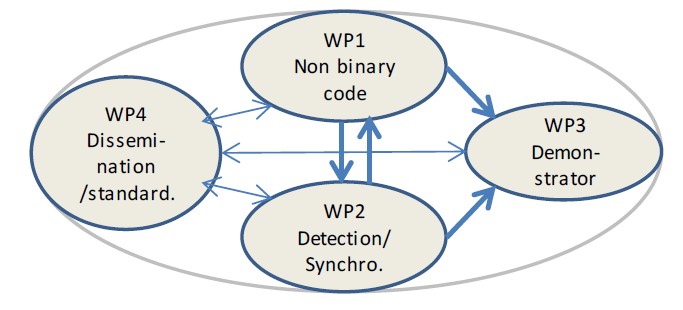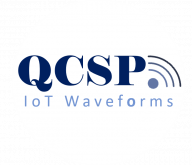The QCSP project is built around 4 main work-packages:

WP1 (NB codes) targets the design and the optimization of low coding rate CCSK-NB-codes. Three families of NB codes will be investigated: NB-Turbo code (by Lab-STICC/IMTA), NB-Polar code (by CEA and ETIS) and NB-LDPC code (by building upon the previous work of Lab-STICC/UBS, CEA and BIU-LIU).
WP2 (demodulation/ synchronization) proposes and evaluates algorithms to achieve an efficient detection and synchronization of the CCSK-modulated Frame using the soft output provided to the decoder and exploiting the particular structure of the frame. Lab-STICC/UBS, CEA and BIU-LIU intend to target the theoretical aspects. ORANGE LABS will feed the WP with use cases linked to the 3GPP standardization and realize related simulations. SEQUANS will contribute on the definition of a suitable channel model for IoT.
The objective of WP3 (Demonstrators) is to design a demonstrator using GNU radio with real-time reception for a set of sensors. In addition to the scheduled work by IMS/IPB, Lab-STICC/UBS, BIU-LIU and ETIS on the demonstrator, ORANGE LABS plans to test the solutions proposed in WP1 and WP2 through experimentations partly based on Open Air Interface.
Finally, WP4 (Dissemination and standardization) will first provide WP1, WP2 and WP3 with the specifications of different existing IoT standards. In particular, the potential requirement of the compatibility of the defined CCSK modulation with the waveform of the targeted standards will be addressed. Then WP4 will compare the pros and cons of the proposed CCSK-NB coded modulation with respect to existing or emerging future propositions to the 3GPP standard. The last objective of WP4 is to support dissemination, first with scientific papers, then with the promotion of the two open source demonstrators developed in WP3, and finally through contributions to the standardization (3GPP in particular) of novel IoT services. ORANGE LABS and SEQUANS will be in charge of the standardization aspects.
Impact and benefits of the project:
All the partners are aware that pushing an original idea generated from the project in a 3GPP standard is a difficult task. However, in case of success, this result would provide undeniable gains in terms of notoriety. To fulfil this goal, a pragmatic approach will be used by the companies of the consortium through several actions. First, the consortium will work on packet size, code rate code and channel model related to the mobile communication in order to be able to make fair comparisons with existing solutions. Second, a demonstrator will be made in WP3 as a proof of concept of promising solutions. Third, the consortium will assess the performance of NB codes associated with 3GPP’s classical waveform and assess the performance of CCSK alone with 3GPP’s binary error control code. Finally, even if the consortium is not able to impact 3GPP standardization in the short-term range, there remain many other applications with high benefits that could be targeted by the project. To cite few of them, the QCSP method can be used to establish a link, through an ALOHA protocol, in a low-earth-orbit constellation of satellites. Since the waveform is, by construction, discrete and can successfully operate at very low SNR, it can also be used for security/military applications. Moreover, many proprietary applications for classical wireless channels or specific channels (powerline, oil well drill-surface, underwater communications, …) may profit from the knowledge generated during the ANR QSCP project. Therefore, specific actions can be undertaken to target influent players in these domains on the long run.

